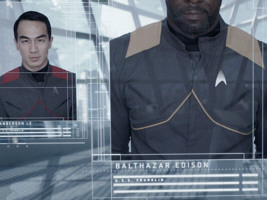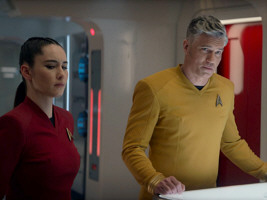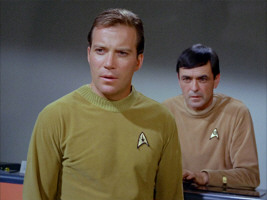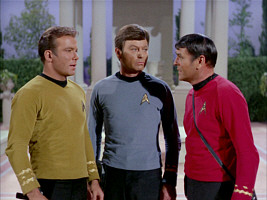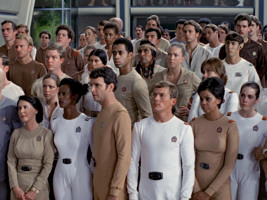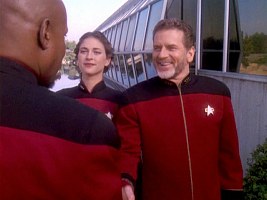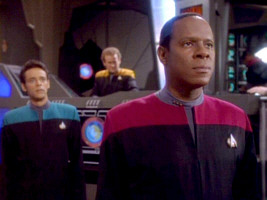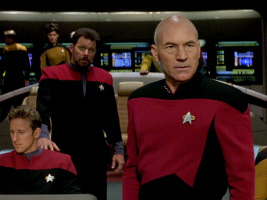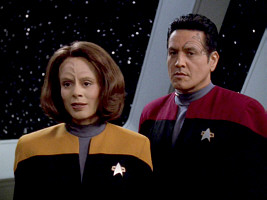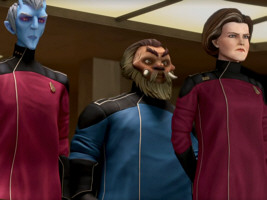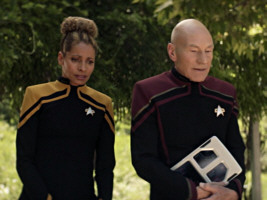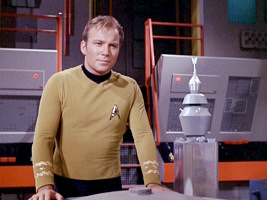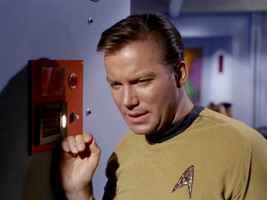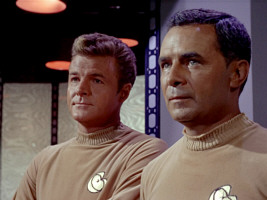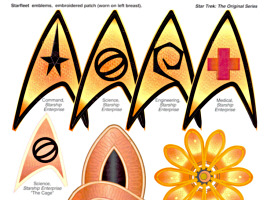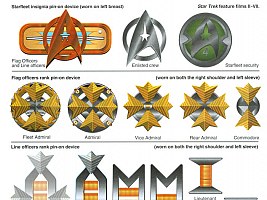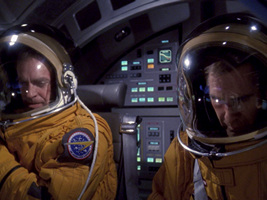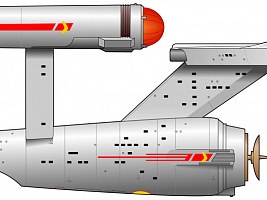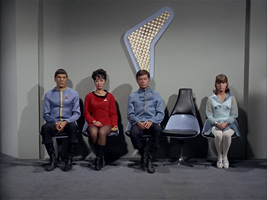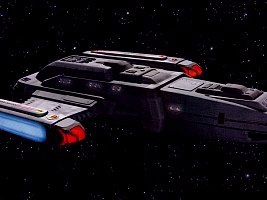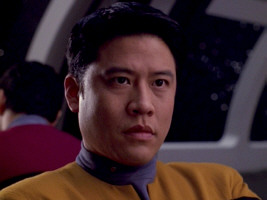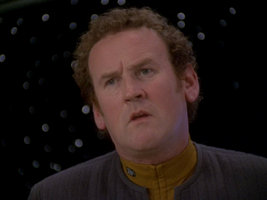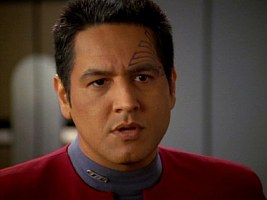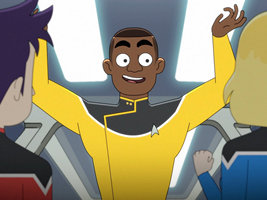Uniform & Rank Inconsistencies
Starfleet's Uniform ChaosThe Color of the TOS Command Uniform ShirtThe Arrowhead as a General Starfleet EmblemStarfleet Rank Oddities
Starfleet's Uniform Chaos
Starfleet's uniform styles change in very irregular intervals, and very often not consistently for all ranks, ships and divisions. Some uniforms must have existed for many decades, whereas others lasted just one single year!
Earth Starfleet uniform
The uniforms worn by Earth Starfleet in the 2150's are not further discussed here, since they predate any other style by 100 years, and there may have been an unknown number of modifications in the 100 years from Enterprise to "The Cage". It is only worth mentioning that on the otherwise navy blue jumpsuits the departments on Enterprise NX-01 are already distinguished by thin stripes of different colors, similar to those of the TOS uniforms: yellow for command, red for engineering and security, green for science. The latter is a presumption. It would make Hoshi a scientist, rather than an officer with an executive position.
Franklin uniform
 In the records seen in "Star Trek Beyond", set in the year 2164, the crew can be seen with what is possibly the very first Federation Starfleet uniform. The style looks much like a blend of the Earth Starfleet jumpsuits and the colorful shirts that would be in use about a hundred years later in all universes. Even the department colors appear to be the same as at the time of TOS.
In the records seen in "Star Trek Beyond", set in the year 2164, the crew can be seen with what is possibly the very first Federation Starfleet uniform. The style looks much like a blend of the Earth Starfleet jumpsuits and the colorful shirts that would be in use about a hundred years later in all universes. Even the department colors appear to be the same as at the time of TOS.
Kelvin uniform
 The crew of the Kelvin in "Star Trek (2009)", set in the year 2233, can be seen with still different uniform colors than in any other time frame. The "command" color, as worn by Captain Robau and George Kirk, appears to be blue here. Since these events in the movie predate the TOS pilots by more than 20 years, it well is possible that a so far unknown uniform exists at the time. Still, it would be extremely odd if there used to be yet another permutation of departmental colors - unless Robau, Kirk and many more of the bridge crew of this science ship were wearing a blue science uniform.
The crew of the Kelvin in "Star Trek (2009)", set in the year 2233, can be seen with still different uniform colors than in any other time frame. The "command" color, as worn by Captain Robau and George Kirk, appears to be blue here. Since these events in the movie predate the TOS pilots by more than 20 years, it well is possible that a so far unknown uniform exists at the time. Still, it would be extremely odd if there used to be yet another permutation of departmental colors - unless Robau, Kirk and many more of the bridge crew of this science ship were wearing a blue science uniform.
Kelvin Timeline Enterprise uniform
 In the Kelvin Timeline, the Enterprise crew (and strangely only the Enterprise crew) can be seen with colorful shirts, similar to the ones of TOS since 2266, as soon as in 2258 ("Star Trek (2009)" and "Star Trek Into Darkness"). These uniforms are slightly redesigned until 2263 ("Star Trek Beyond"). These variations are not further taken into account in this article.
In the Kelvin Timeline, the Enterprise crew (and strangely only the Enterprise crew) can be seen with colorful shirts, similar to the ones of TOS since 2266, as soon as in 2258 ("Star Trek (2009)" and "Star Trek Into Darkness"). These uniforms are slightly redesigned until 2263 ("Star Trek Beyond"). These variations are not further taken into account in this article.
Discoverse uniforms
 Star Trek Discovery comes up with still different all-blue uniforms than in either "The Cage" or the Abramsverse. The department colors can be found as gold, silver and copper stripes on the uniforms and are hardly recognizable as such. This style is in use in the years 2256 and 2257 but also as soon as in 2239 (SHO: "The Brightest Star"). In the second season of the series, set in 2257, the Enterprise crew already has the uniforms (or at least re-imaginations thereof) that the TOS crew would wear as late as after 2265. The similarity to TOS is a tip of the hat (or a visual bridge), rather than a genuine attempt to adhere to the continuity of classic Trek. This is also evidenced by the decision to keep the odd asymmetric collars of the Discovery uniforms, which are even more noticeable on the TOS reboot uniforms. And although the Discovery-style Enterprise uniforms are explicitly called "new" in DIS: "Brother", they date back at least to the year 2254, as evidenced in SHO: "Q&A". The fact that Strange New Worlds introduces still different reimagined uniforms in its first season, set in 2258, ultimately creates an irresolvable mess. What's more, these allegedly still newer uniforms are worn by the crew members visiting Rigel VII five years earlier in SNW: "Among the Lotus Eaters"! Although they belong to the smaller problems of these prequels that were conceptualized as visual reboots, the numerous uniform oddities of the Discoverse remain inexplicable. They are disregarded in this article for the sake of our sanity.
Star Trek Discovery comes up with still different all-blue uniforms than in either "The Cage" or the Abramsverse. The department colors can be found as gold, silver and copper stripes on the uniforms and are hardly recognizable as such. This style is in use in the years 2256 and 2257 but also as soon as in 2239 (SHO: "The Brightest Star"). In the second season of the series, set in 2257, the Enterprise crew already has the uniforms (or at least re-imaginations thereof) that the TOS crew would wear as late as after 2265. The similarity to TOS is a tip of the hat (or a visual bridge), rather than a genuine attempt to adhere to the continuity of classic Trek. This is also evidenced by the decision to keep the odd asymmetric collars of the Discovery uniforms, which are even more noticeable on the TOS reboot uniforms. And although the Discovery-style Enterprise uniforms are explicitly called "new" in DIS: "Brother", they date back at least to the year 2254, as evidenced in SHO: "Q&A". The fact that Strange New Worlds introduces still different reimagined uniforms in its first season, set in 2258, ultimately creates an irresolvable mess. What's more, these allegedly still newer uniforms are worn by the crew members visiting Rigel VII five years earlier in SNW: "Among the Lotus Eaters"! Although they belong to the smaller problems of these prequels that were conceptualized as visual reboots, the numerous uniform oddities of the Discoverse remain inexplicable. They are disregarded in this article for the sake of our sanity.
TOS Pilots uniform
Pastel-colored uniforms were created for the first Star Trek pilot, "The Cage" (2254). The uniforms reappeared in "Where No Man Has Gone Before" (2265), with slight modifications to the rank signs. They are still worn by the Antares crew in TOS: "Charlie X" (2266). Hence, this style must have lasted for at least twelve years.
TOS uniform
With the beginning of TOS (2266), the more colorful yellow, red and blue uniform shirts were introduced. This is the by far most famous style in the real world, so much that the Abramsverse, Discovery and Strange New Worlds all created their proprietary re-imaginations of the pattern and the colors, just to establish a visual bridge to pre-reboot Trek. Yet, the TOS uniform was extremely short-lived in-universe. It must have been abandoned some time prior to "Star Trek: The Motion Picture" (2271), at least as the Enterprise and Earth-based personnel were concerned.
TMP uniform
At the time of "Star Trek: The Motion Picture", several new uniform patterns with toned down colors can be seen, plus a standardized arrowhead emblem for all ships and departments of Starfleet.
Movie uniform
Some time between "Star Trek: The Motion Picture" (2271) and "Star Trek II" (2285), there must have been yet another switch of uniforms, and a radical one this time. The shirts were supplemented with asymmetrical jackets, the colors of most uniform jackets were narrowed down to red only, and the rank signs became quite different from anything seen so far. The department was still indicated by the shirt colors, but usually only their collar was visible. These red uniforms must have been introduced prior to 2278, the year that the USS Bozeman came from, whose crew is wearing this style in TNG: "Cause and Effect". This movie pattern remained in use unchanged for another fifteen years, at least until the maiden voyage of the Enterprise-B in "Star Trek Generations" (2293).
Basically the same untypical uniform style was preserved for an extraordinarily long time. A slight variant of the movie uniform can be seen as late as in the mid-24th century, only without the colored pullover collar underneath the jacket and later without the belt. The tailoring has remained the same. This simplified uniform is consistently used in in Q's recreated past TNG: "Tapestry" (2327), in TNG: "Yesterday's Enterprise" (2344) and still by Jack Crusher in a holographic recording in TNG: "Family" (2349). The re-use of the movie uniforms was an obvious choice, as it helped save production budget. Anyway, Starfleet must have eventually retired it between 2349 and 2355, seeing that Picard's crew in the flashbacks in TNG: "The Battle" (2355) wears Starfleet standard issue of the 2360's, the same as in early TNG.
TNG I uniform
Around 2350, after some 70 years, Starfleet's uniforms returned to a style of different uniform shirt colors for the departments (TNG I). Rank signs are since then reduced to small ranks pips, which are consistently worn also with the following 24th century uniforms. For some time there used to be a female variant with a skirt again, and even men were occasionally seen with a skirt (tentatively named "skant" by the costume designers).
 In DIS: "Terra Firma I", Commander Yor, the "time soldier", can be seen in a Starfleet uniform from the early 2360's, although Kovich says he came from the year 2379 (of the Kelvin Timeline) and traveled forward in time (to the Prime Universe). There may have been reasons for him to wear an anachronistic uniform, or the depiction actually shows him on a previous time travel.
In DIS: "Terra Firma I", Commander Yor, the "time soldier", can be seen in a Starfleet uniform from the early 2360's, although Kovich says he came from the year 2379 (of the Kelvin Timeline) and traveled forward in time (to the Prime Universe). There may have been reasons for him to wear an anachronistic uniform, or the depiction actually shows him on a previous time travel.
TNG II uniform
The TNG I unisex uniform of 2364 was a jumpsuit, but later modified to a shirt-&-pants version with a belt (2366). Also, a collar was added. This new uniform (TNG II) was initially only worn by the higher ranking officers (or rather the main characters) until the end of 2366. On a different note, a variety of admiral's uniforms is known, all following the same basic pattern, but with slightly different jackets.
DS9/Voyager uniform
After only three years, yet another a new uniform was created, with the colors of the upper and lower half of the shirt reversed and a new bluish gray undershirt whose collar sticks out. Also, a new communicator was introduced, replacing the oval body with a rounded trapezoid. This uniform was worn on DS9 (2369), but did not affect the style on the Enterprise-D until the end of TNG (2370). Quite obviously the real-world reason is that it should be easier for the viewer to tell the two different series apart. The DS9 uniform may have been supposed to be an additional, maybe more practical variant to the TNG style. But the first TNG feature film "Generations" (2371) came with a total uniform chaos. Both the TNG and DS9 style were worn in parallel (the main characters were all TNG-clad at first), with a visible tendency towards the DS9 version.
Still, several branches in Starfleet must have retained the TNG version longer than on the Enterprise-D. Actually, most of the non-DS9 personnel seen until season 4, and all higher-ranking non-DS9 officers, seemed to wear the TNG variant. Examples include Calvin Hudson in "The Maquis", Dr. Lens from the Lexington in "Explorers", the crew of the USS Odyssey in "The Jem'Hadar", Thomas Riker in "Defiant" and finally Worf in "The Way of the Warrior". Most obviously the TNG uniforms could be witnessed in DS9: "Homefront" and "Paradise Lost", where also Sisko switched to this style - even before Admiral Leyton announced that he would become Earth's security chief! It is possible that specifically Earth- or planet-based personnel retained the old colors, while ship and space station crews adopted the new ones beginning in 2369 or even earlier. Moreover, the dress uniforms remained the same, also on DS9. There may have been a directive that both variants were permissible for a limited time. Voyager consistently sported the new colors from the start (2371), at a time when they were changing at random on the Enterprise-D. Riker appeared in the TNG II uniform as late as in VOY: "Death Wish" (2372). But this Riker may have come from any year between 2366 to 2371.
First Contact uniform
Oddly, the year 2373 brought us yet another new uniform. First featured in "Star Trek: First Contact" (2373), the new gray/black combination was adopted by the DS9 personnel in the same year. Moreover, quite unlike it was the case with the inconsequential previous switch, all of Starfleet's personnel were seen with the new uniform after 2373. The crew of Voyager is the only notable exception. Equipped with replicators, they could have easily switched after contact was made with Starfleet (2374), but the old uniform was in use until the series finale (2378). Certainly the real-world reason is once again to establish a distinct look of the series. An in-universe explanation could be that Janeway decided not to waste their scarce energy reserves on new uniforms (bearing in mind that even in the real-world US Navy implementing a dress code is to some extent at the captain's discretion).
Lower Decks and Prodigy uniforms
 Lower Decks takes place in the early 2380's, Prodigy in the mid-2380's. Both animated series feature new uniforms, which must exist concurrently with those in the live-action series and movies. At least Lower Decks also shows the "First Contact" style as it was the standard at the time. The animated-only variations are not further taken into account in this article.
Lower Decks takes place in the early 2380's, Prodigy in the mid-2380's. Both animated series feature new uniforms, which must exist concurrently with those in the live-action series and movies. At least Lower Decks also shows the "First Contact" style as it was the standard at the time. The animated-only variations are not further taken into account in this article.
Post-Nemesis uniform
In a flashback in PIC: "The End is the Beginning", we can see Admiral Jean-Luc Picard and Commander Raffaela Musiker with uniforms resembling the DS9 style. The most notable differences are that the border between the colorful shoulder portion and the otherwise dark gray shirt is not straight, and there is a separate colorful stripe. We see only the red and yellow colors, but it seems obvious that the blue variation of this style exists as well. This uniform apparently replaces the one that was introduced in "First Contact".
Picard I uniform
The regular Starfleet uniform of the year 2399 can be seen since PIC: "Maps and Legends". It closely resembles the DS9 variation. Most notably, a collar was added, and the rank pips were moved to the right chest. Admiral Clancy's uniform is somewhat different, and is gray instead of red. But that may be her prerogative as Commander-in-chief.
Picard II uniform
Season II of Picard, set in the year 2401, brings another new Starfleet uniform. The basic colors are still the same, but the jackets now have some sort of asymmetrical lapel.
Alternate uniforms
Something that may be taken into account is the future and parallel timeline uniforms. The uniform in TNG: "Yesterday's Enterprise" had a different collar and an additional white belt. TNG: "Future Imperfect" and "Parallels" both showed the same uniform variant with an identical pattern to the regular TNG II uniform, only with different communicators. But more interestingly, there exist three episodes set in the future with identical uniforms, namely TNG: "All Good Things" (2395), DS9: "The Visitor" (2422), and VOY: "Endgame" (2404). Before Star Trek Picard, there was a good chance that this would be the actual uniform of the future (or better: the uniform of the actual future), considering that it seems to be a constant in the repeated alterations to the timeline. Geordi still wears the "First Contact" uniform in VOY: "Timeless" (2389), which would put the introduction of the "alternate future style" between 2389 and 2395. This clashes with the various different uniforms seen in Star Trek Picard. However, Picard at least adopted the "future-style" Starfleet arrowhead, since "The Last Generation" even with the golden field.
Here is a summary of Starfleet's uniform styles (without animated series and re-imaginations):
| Depiction | Name | In use since | until | Duration |
 |
TOS Pilots | prior to 2254 | 2266 | >12 years |
 |
TOS | 2266 | 2268 to 2271 | 3..5 years |
 |
TMP | 2268 to 2271 | prior to 2278 | <10 years |
 |
Movie (w/ and w/o collar) |
prior to 2278 | 2349 to 2355 | >71 years |
 |
TNG I | 2349 to 2355 | 2367 | 12..18 years |
 |
TNG II | 2366 | 2373 | 7 years |
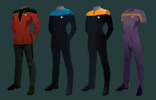 |
DS9 / Voyager | 2369 | 2373 | 4 years |
 |
First Contact | 2373 | 2379 to 2385 | 6..12 years |
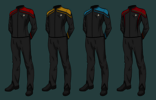 |
Post-Nemesis | after 2379 | prior to 2399 | <20 years |
 |
Picard I | after 2385 | after 2399 | >3 years |
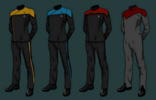 |
Picard II | after 2399 | soon after 2401 | <3 years |
 |
Alternate future | prior to 2395 | 2422 | >27 years |
Summarizing, there is nothing really inconsistent about the life spans of Starfleet's uniforms. On the contrary, with the exception of Discovery, we never see any uniform versions, even in flashbacks or time travels, that we would have to reject as anachronistic. But the question remains whether Starfleet could possibly be so much into fashion that they would retain most of the various styles only for a couple of years, and replace them without any obvious reason. It would be somewhat more plausible if every single style had lasted at least one or two decades. The fact that Starfleet kept the most untypical uniform of the many styles we know of for the by far longest time remains an oddity.

Starfleet uniform @ Memory Alpha
The Color of the TOS Command Uniform Shirt
The color of the uniform shirt that Kirk, Sulu and Chekov wear most of the time is commonly described as "mustard", "gold" or simply "yellow". At least, this is what it usually appears to be on screen in TOS episodes, in the original TV version as well as in the remastered release. This, however, is not the whole truth. William Ware Theiss, who was responsible for the costumes of TOS, had in mind that the three departments of the ship should be represented by the three primary colors in additive color mixing as used for color TV: blue for science and medical, red for engineering and security, green for command. In fact, Kirk has a variant of the uniform, the so-called wrap-around shirt that was made of a different fabric and always appears green in the episodes. His shiny dress uniform is clearly green as well. Kirk's standard shirt, on the other hand, was made of an avocado green fabric that only appears yellow, owing to the conditions of the film material, the lighting and the processing of the film.
More precisely, an article at startrek.com lists five factors that create our impression of a yellowish shirt, instead of a green one. The first is the Eastman Kodak 35mm film used at the time, which was meant to produce "warmer" colors and which would shift greenish colors to red, making light green appear as plain yellow (and yellow as pink, as it used to happen with Spock's skin color). The second reason is the lighting with tungsten, whose color temperature is lower and hence makes the colors appear more red as well. The three other reasons for color variations are color timing, optical effects and the transfer to tape or digitizing, all of which are not free of imperfections.
 In TOS-R, the colors are generally somewhat different than in the original episodes, and presumably closer to what they might have looked to the naked eye. In particular, the color of Kirk's shirt sometimes reveals its actual greenish hue, albeit usually not as clearly as in TOS-R: "The Changeling".
In TOS-R, the colors are generally somewhat different than in the original episodes, and presumably closer to what they might have looked to the naked eye. In particular, the color of Kirk's shirt sometimes reveals its actual greenish hue, albeit usually not as clearly as in TOS-R: "The Changeling".
The Arrowhead as a General Starfleet Emblem
The arrowhead in TOS: just representing the Enterprise?
From at least 2254 ("The Cage") to 2268 (the end of TOS), all crew members of the original USS Enterprise NCC-1701 consistently wear an arrowhead emblem on their uniforms, with an inner symbol denoting the ship's department they belong to (command, science, operations, medical). Other TOS-era Starfleet personnel is usually seen with the same uniform style, colors and rank signs, but with different emblems. One of these other emblems resembles a flower. It is commonly associated with Starfleet Command. Chest insignias other than the arrowhead and Starfleet Command can be seen in three TOS episodes, always worn by ship crew members: (U)SS Antares in TOS: "Charlie X", USS Constellation in TOS: "The Doomsday Machine", USS Exeter in TOS: "The Omega Glory". ENT: "In a Mirror Darkly" adds the emblem of the USS Defiant to the mix.
 The USS Huron crew in TAS: "More Tribbles, More Troubles" can be seen with a different insignia as well. This would give us five appearances of (ship?) emblems other than the arrowhead, three during TOS, and two more inspired by the diversity of TOS symbols.
The USS Huron crew in TAS: "More Tribbles, More Troubles" can be seen with a different insignia as well. This would give us five appearances of (ship?) emblems other than the arrowhead, three during TOS, and two more inspired by the diversity of TOS symbols.
For decades, it seemed to be set in stone that the arrowhead symbol represented just the Enterprise at the time of TOS, and that each starship (or at least, each of the twelve Starship/Constitution-class vessels) had its individual symbol. This used to be the commonly accepted explanation for the different emblems until 2017. And it was more or less official (albeit not canon) because the existence of individual ship emblems was confirmed in all editions of the Star Trek Encyclopedia.
In all uniform variants since "Star Trek: The Motion Picture" (2271), all of Starfleet's personnel consistently wears the arrowhead (in many slight variations). We can still see the personnel of the Epsilon IX station with an individual emblem in 2271, so the transition may not have been abrupt, though. Anyway, if the arrowhead previously was the symbol of the Enterprise, there are two possibilities: Either the famous voyages of the Starship Enterprise have inspired Starfleet to adopt the ship's individual symbol for the whole organization, or the arrowhead had been a common identification symbol of Starfleet already prior to TOS, and was worn exclusively on the Enterprise only for that limited period - maybe because the Enterprise was the fleet's flagship or was considered something otherwise special. The latter is supported by the appearance of the arrowhead as soon as on the Friendship One UESPA probe (see below).
An article published at startrek.com in 2017 sheds new light on this very old issue. In a memorandum from December 18, 1967, Bob Justman, on behalf of Gene Roddenberry, stated that the arrowhead is meant to be the common insignia of all starship crews. The crew of the Antares, which were already seen with a different emblem at the time of the memo, are members of the merchant marine and "not entitled to bear this proud insignia". We can make the same case for the USS Huron emblem that is not mentioned in the article. The memo purportedly came too late to prevent William Ware Theiss from creating different insignia for Commodore Decker (USS Constellation) and still for Captain Tracey and Dr. Carter (USS Exeter). "The Omega Glory" was just being filmed at the date of the document.
While behind-the-scenes information like Justman's memo would be overruled by canon evidence, it is worthwhile to review the arrowhead issue in light of the idea of a common starship crew emblem. In fact, we could see non-Enterprise starship personnel with arrowhead insignias on two occasions in TOS: two Starfleet officers who are not in Kirk's crew in the Starbase club in "Court Martial" (possibly more, but only these two implicitly identify themselves as being from another ship) and bodies of Defiant crewmen in "The Tholian Web". These would support the theory that all starship personnel wear the arrowhead insignia. Since we never see any of his crew (because they have left the ship and are all dead by the time), we may explain Commodore Decker's different emblem with him being a flag officer with a permanent field commission. This makes Tracey and Carter the only anomalies at the time of TOS, because why should just these two have a different insignia than the rest of their dead crew that we never see? Overall, it seems like the lesser evil to go with the conclusion of the startrek.com article and accept the two Exeter officers with their non-standard emblem as an exception, so the crew members in the Starbase club and on the Defiant would wear a regular emblem.
If we take into account ENT: "In a Mirror, Darkly", however, the situation is different. The arrowhead as the universal starship symbol produces quite a few more exceptions to the rule. The startrek.com article discreetly ignores the Enterprise episode (maybe because it is based on "false" suppositions). But even though ENT: "In a Mirror, Darkly" episode disregards the rule that Roddenberry and Justman made up (or rather, was made without any knowledge of the obscure document), it is fully canon and has definitely more weight than the meanwhile resurfaced memo.
 The crew of the Kelvin can be seen wearing the Starfleet arrowhead on their uniforms as soon as in 2233. Therefore it is still a possibility in the Abramsverse that the arrowhead represented all crews of Starfleet before it became a special symbol of the Enterprise for a limited time in the 2260s.
The crew of the Kelvin can be seen wearing the Starfleet arrowhead on their uniforms as soon as in 2233. Therefore it is still a possibility in the Abramsverse that the arrowhead represented all crews of Starfleet before it became a special symbol of the Enterprise for a limited time in the 2260s.
 Star Trek Discovery and Strange New Worlds show all Starfleet personnel exclusively with the Starfleet arrowhead in the 23rd century, now apparently with the more or less official blessing from the startrek.com article that something like individual ship emblems never existed. It doesn't seem to be a coincidence that the article was published right after the launch of Discovery in 2017.
Star Trek Discovery and Strange New Worlds show all Starfleet personnel exclusively with the Starfleet arrowhead in the 23rd century, now apparently with the more or less official blessing from the startrek.com article that something like individual ship emblems never existed. It doesn't seem to be a coincidence that the article was published right after the launch of Discovery in 2017.
Age of the arrowhead symbol
It is interesting to note that the long-range probe Friendship One (UESPA-1) in the Voyager episode of the same name sported the arrowhead, here as the symbol of the UESPA (United Earth Space Probe Agency), as early as in 2067. But Earth Starfleet has apparently abandoned or has never used the arrowhead symbol by 2143, as we could see a somewhat different, NASA-like Starfleet Command symbol, perhaps symbolizing a spacecraft trajectory, in ENT: "First Flight" and in other episodes taking place between 2151 and 2155. ENT: "Demons" finally showed a seal with this Starfleet symbol and the additional words "United Earth Space Probe Agency", implying that Starfleet Command is a part of UESPA. If both organizations are the same or one is a department of the other, it is only plausible that symbols are interchangeable and that at a later date the arrowhead could come into use again -- even if the UESPA was renamed, demerged or abandoned some time between ENT and TOS.
The "boomerang" symbol
The "boomerang" symbol can be seen as the pennant on Federation Starfleet ships at the time of TOS, such as the USS Enterprise NCC-1701. The symbol is also visible as a wall decoration in the courtroom in TOS: "Court Martial". A more angular boomerang appears as the individual ship emblem of the USS Defiant NCC-1764 in ENT: "In a Mirror, Darkly". It is unknown what the boomerang signifies. It looks a bit like the Starfleet arrowhead. Considering that the Starfleet arrowhead is often turned by 90 degrees when displayed on ship hulls (since 2271) or on Kirk's first-season wrap-around uniform (2265), just like the boomerang, it is well possible that the boomerang is an alternative Starfleet emblem - but one that was abandoned, perhaps because it looked so crude.
A modified boomerang reappears on the pennant of the (U.)S.S. Raven NAR-32450 in VOY: "Dark Frontier", here denoting either a civilian ship registered in the Federation or a Starfleet science ship, depending on which of the two conflicting prefixes that were mentioned, SS or USS, we lend more credence.
Starfleet Rank Oddities
Inconsistent promotions
Usually one might expect that a Starfleet officer receives a promotion every few years, depending on his or her conduct and performance. Most permanent crew members in the various Star Trek series have moved up the ranks through the years, but some have not. There may be certain special conditions to consider. As Picard said to Kirk in "Generations", accepting a promotion to admiral would probably mean that he lost his command over a starship. This was also the reason why he declined the offer to become the head of Starfleet Academy (with the rank of admiral) in TNG: "Conspiracy", and why Kirk was not too sad when he was demoted at the end of "Star Trek IV". Riker remained commander during all his time under Capt. Picard, 15 years altogether until "Star Trek Nemesis". He declined a command of his own four times. It is possible that there can be only one person with the rank of captain on a starship (the notable exception being the Enterprise-A with Captains Kirk, Spock and Scott).
Ensign Harry Kim, on the other hand, is a crew member who is never promoted in his whole seven years on Voyager, although no good reason becomes obvious. He finally complains about that in VOY: "Nightingale", blaming the exceptional circumstances in the Delta Quadrant for the stagnation, whereas he might be lieutenant, even lieutenant commander by now in the Alpha Quadrant. The rationale may seem plausible, as the rank structure might need lower officer ranks. Still, why is Tom promoted to lieutenant (jr. grade) again in VOY: "Unimatrix Zero", after he had been demoted to ensign in VOY: "Thirty Days"? Clearly Harry Kim's record has been better in the meantime. Other crew members who were apparently let down include Lt. Commander Data. Like Riker, he has been holding this rank for 15 years, although in his case there was no apparent reason why he shouldn't move up to the rank of commander, just like Deanna Troi in TNG: "Thine Own Self" (the episode even has an ironic remark that Deanna now outranks Data). Curiously, Deanna's promotion went along with an exam to acquire command ability, but Data had been in command before without holding the rank of commander.
 In "Star Trek (2009)" Cadet Kirk is promoted by Captain Pike to the Enterprise's first officer. Some time later Spock, acting captain at that time, puts him in command. At the end of the movie Kirk, who should nominally still be a cadet, receives his promotion to captain, skipping no less than five ranks! This is very odd and unprecedented in the history of Star Trek. It has been argued that Pike or Spock may have given Kirk a field promotion, one that Starfleet wouldn't revert after Kirk has saved the planet. But Kirk did not act single-handedly, he received crucial support from Spock and his other crew members. If anyone, then Commander Spock should have been promoted to captain. Also, no one else in Starfleet that we know of has ever been promoted because of a single merit. Ironically, the Prime Universe Kirk was demoted to captain after saving Earth in "Star Trek IV"! And even more ironically, when new Kirk commits a minor offense by cheating the Kobayashi Maru scenario, he is going to be disciplined, while after numerous more serious offenses he is promoted! So whatever we make of Kirk's incredibly premature promotion, it leaves a bad taste of Starfleet valuing isolated accomplishments or even "predestination" higher than constancy. Although it is not unprecedented in military history for outsiders to take leading positions, a military organization should not work like this.
In "Star Trek (2009)" Cadet Kirk is promoted by Captain Pike to the Enterprise's first officer. Some time later Spock, acting captain at that time, puts him in command. At the end of the movie Kirk, who should nominally still be a cadet, receives his promotion to captain, skipping no less than five ranks! This is very odd and unprecedented in the history of Star Trek. It has been argued that Pike or Spock may have given Kirk a field promotion, one that Starfleet wouldn't revert after Kirk has saved the planet. But Kirk did not act single-handedly, he received crucial support from Spock and his other crew members. If anyone, then Commander Spock should have been promoted to captain. Also, no one else in Starfleet that we know of has ever been promoted because of a single merit. Ironically, the Prime Universe Kirk was demoted to captain after saving Earth in "Star Trek IV"! And even more ironically, when new Kirk commits a minor offense by cheating the Kobayashi Maru scenario, he is going to be disciplined, while after numerous more serious offenses he is promoted! So whatever we make of Kirk's incredibly premature promotion, it leaves a bad taste of Starfleet valuing isolated accomplishments or even "predestination" higher than constancy. Although it is not unprecedented in military history for outsiders to take leading positions, a military organization should not work like this.
O'Brien and other non-commissioned officers
The rank signs of officers at the time of early TNG are well-defined: one solid pip for the ensign, one solid and one hollow for the lieutenant junior grade, two solid for the full lieutenant, two solid and one hollow for the lieutenant commander, and so on. The supposedly existing lower ranks on the Enterprise have no insignia, a visual identification is impossible. Most importantly, there is no distinction between enlisted crewmen and non-commissioned officers (NCO). The obvious interpretation: there exist no non-commissioned officers at the time of TNG, just officers (who have graduated at Starfleet Academy) and crewmen (without graduation). Although this seems logical, it would be unfair to the crewmen, who could never rise in their rank. There would be no chance, with less of an effort than at Starfleet Academy, to receive a promotion to a non-commissioned officer rank, possibly as a field promotion. Becoming a "crewman first class" after years in service without any visible distinction seems anything but desirable.
Miles Edward O'Brien is wearing the solid pip of an ensign in TNG: "Encounter at Farpoint" and still in the (correctly in his case) recreated past of TNG: "All Good Things". From season 2 to 5 of TNG, his rank sign is the two solid pips of a lieutenant, and he is accordingly addressed by Riker in "Where Silence Has Lease".
Since TNG: "Family", however, we know that there are intended to be non-commissioned officers and that O'Brien is supposed to be one of them. Sergey Rozhenko introduces himself as an engineer and chief petty officer (CPO). Oddly, he identifies Miles O'Brien as another CPO -- but O'Brien is clearly wearing lieutenant rank signs at that time (two solid pips). It is possible that the writer of the episode thought that "(Transporter) Chief", as O'Brien was commonly referred to, was a rank rather than a function. Anyway, one theory is that there is an unknown number of non-commissioned officers aboard any starship, wearing the rank signs of the equivalent officer whose position they occupy. Although an ensign has a higher nominal rank than any NCO, it is possible for NCO ranks to perform the duty of an officer also in many real-world military organizations. Either because of their experience or because of a lack of officers. And perhaps, since no visual distinction is possible anyway, these NCOs would be referred to as if they were officers. Of course, that still wouldn't explain why Rozhenko could see that O'Brien is a CPO -- maybe Miles just looks like that?
Anyway, O'Brien's rank is clearly meant to be retconned by the viewer. He has never been demoted. He has never been an officer. He explicitly says "And don't call me 'sir'. I'm not an officer." to Muniz in DS9: "The Ship". Since his last appearances on TNG O'Brien is wearing rank signs different from the officers, definitely denoting him as something less than an ensign. At first, it was an empty pip, which would comply with the TNG rank system rather as a cadet than as an NCO. Nonetheless it is quite fitting, considering that the sign is identified as "Chief Warrant Officer" in the Star Trek Encyclopedia. Warrant officers are an intermediate group of ranks between an NCO and an officer but with an officer's duties in the US Navy, just like I have already speculated earlier. Also, it would confirm that O'Brien had received a promotion (rather than a demotion) prior to changing to DS9, which is mentioned in DS9: "Past Prologue", because a chief warrant officer is a higher rank than a chief petty officer.
O'Brien first wears the hollow pip on the Enterprise in TNG: "Realm of Fear", and he remains on board with this rank sign until TNG: "Rascals" (sixth season). The empty pip must have been introduced earlier. It appeared as early as in the second TNG season in "The Child" (Gladstone), then in TNG: "Reunion" (Maggie Hubble), TNG: "Night Terrors" (Gillespie), TNG: "The Next Phase" (Brossmer) and TNG: "The Quality of Life" (Kelso). There was also a woman in engineering in TNG: "The Next Phase" (fifth season) with this rank sign, and she was called "Chief" by Data. (It is actually her who saves the ship when she interrupts Picard's "engage" command that would have destroyed the ship.)
Later on in DS9, O'Brien's rank sign is modified to a combination of three chevrons and two dots, much like the master chief petty officer in the US Navy (three chevrons and two stars). This insignia is quite plausibly identified as "Chief Petty Officer" in DS9: "Hippocratic Oath". But has he been demoted? The Star Trek Encyclopedia calls this rank "Chief of Operations", which sounds rather like an occupation than a rank. In DS9: "Tribunal" O'Brien states "My name is Miles O'Brien. My rank is chief of operations, Starfleet. I am a Federation citizen.". But that was at a time when he still wore the hollow pip. The hollow pip could be an exceptional rank sign, considering that O'Brien was always called "Chief", while he was wearing this one, and not "Chief Warrant Officer". This would mean that O'Brien hasn't been demoted, and he may have been promoted from chief petty officer to master chief petty officer since his time on the Enterprise. More evidence that he may have climbed up the ranks comes from DS9: "Shadow Play", where O'Brien states that he is a "Senior Chief Specialist", which is the NCO in the US Navy closest to an officer rank, a senior chief petty officer with the status of a specialist.
Overall, a rank identification system would not be very practical if there were only one rank sign for the highest NCO (namely the hollow pip) or an intermediate warrant officer rank, while all other NCO ranks (if there is one, there must exist more) as well as the enlisted crew would have no rank signs. Yet, this seemed to be the case at the time of (early) TNG. Crewman 1st Class Tarses in TNG: "The Drumhead", for example, has no rank sign that would have allowed to distinguish him from a crewman 3rd class. In this regard the revision to introduce combinations of chevrons and dots for the NCO ranks is clearly an improvement. But we can't really tell if this is so. Apparently O'Brien remains one of extremely few NCOs in Starfleet. Only Cadet Dorian Collins in DS9: "Valiant" (the girl from the moon), one more female crew member of that ship, and Burke from DS9: "Nor the Battle to the Strong" wear a similar or the same rank sign with three chevrons. The provisional(?) rank of Cadet(?) Collins is just another oddity, considering that most of her fellow cadets were "promoted" to officer ranks. All other non-commissioned personnel are referred to only as "crewman" or at most as "crewman first class".
Another strange fact about O'Brien is that he was at Starfleet Academy indeed, where he studied engineering and underwent an extensive education and training. The same might apply to Dorian Collins who, if she was really about to become an NCO, would even be in the same class as the future officers. If it is only a few more months and a few more courses, why would anyone not want to become an officer? Especially someone as brilliant as O'Brien who was (most likely) not married at that time? Maybe his engineering studies were so extensive that he neglected the non-technical part. In spite of his undeniable merits, he is more than lucky that Starfleet would ask him to teach engineering (DS9: "What You Leave Behind"), although he has never made it to officer.
Tom's and Tuvok's ranks
Sometimes Starfleet officers are not wearing the rank signs they are supposed to have. The most obvious example is Tom Paris and Tuvok. Tom is field promoted to lieutenant by Janeway in VOY: "Caretaker". We can't tell if he is supposed to be lieutenant or lieutenant jr. grade, as both would be called "Lieutenant". Anyway, he is wearing the full lieutenant rank sign (two solid pips) for most of the first season. Tuvok wears lieutenant commander insignia from the beginning, but the opening credits call him "Lieutenant", and he was occasionally referred to as "Lieutenant", never correctly as "Commander". Towards the end of the first season, in "Faces", Tom's rank sign was changed to lt. junior grade. In "Cathexis", Tuvok's was changed to lieutenant. Were they both demoted?
Although it appears to be just retconning (bearing in mind that Tuvok was supposed to be lieutenant from the beginning, as per the episode credits), his demotion seems possible. Tuvok was involved in the incident in VOY: "Prime Factors", making an illegal deal on Sikaris and putting the ship in danger. This seems like a sufficient reason to demote him, but not Tom. Also, for some reason the demotion did not take effect immediately, but a couple of episodes later. Maybe Janeway was waiting for the result of an official investigation, before taking actions.
However, Tuvok's rank pips kept changing during "Cathexis", without any explanation what was going on. Also, there is still the question why Tom was demoted, although his role in the "Prime Factors" plot was at most marginal, while B'Elanna's was not. Another problem is that Janeway promotes Tuvok to lt. commander again in VOY: "Revulsion". She says, "Over the past nine years I've come to rely on his insightful and unfailingly logical advice...", suggesting that he was having the same rank all the time.
More evidence can be found in VOY: "Worst Case Scenario" where both holographic characters Paris and Tuvok appear with their lower ranks, although at the time Tuvok wrote the program and Seska may have been the last person to ever touch it, they still had their respective higher ranks. It appears that the fact that Tuvok and Paris ever had higher ranks is consciously disregarded and retroactively invalidated.
Chakotay's rank
After VOY: "Caretaker" Chakotay becomes Captain Janeway's first officer. But it is uncertain whether his provisional rank, which he retains for the whole run of the series, is commander (CMDR) or lieutenant commander (LTCDR). He is consistently called "Commander", but that would be the proper way to address a LTCDR as well.
Arguments for LTCDR:
-
His Maquis insignia clearly imitates that of a Starfleet LTCDR, with its two solid and one black stripe. It is the only one of its kind we ever see, and there is no canon reference to what it means, just common sense. Bearing in mind that Tuvok's and Tom's rank pips were fixed to reflect their intended ranks as mentioned earlier but Chakotay's remained the same, it seems he was always meant to be a LTCDR.
-
The former XO he replaced, Cavit, was a LTCDR. This doesn't have to mean a lot though, considering that the provisional promotion was a "political" decision and Janeway may have taken into account Chakotay's previous merits (perhaps he really was a Starfleet commander?), rather than those of his predecessor.
Arguments for CMDR:
-
He is never referred to as LTCDR on screen, not once in seven years. Even though it is correct to address a LTCDR as "Commander", he ought to be called "Lieutenant Commander Chakotay" whenever someone is talking about him to a third person. Data, for instance, was frequently referred to as a "lieutenant commander".
-
In VOY: "In the Flesh", the faux Boothby states Chakotay's serial number and rank as plain CMDR. Granted, that was a simulation, but Species 8472 must have got its info from Voyager.
-
He is called "Commander Chakotay" in the title credits and in all scripts.
Summarizing, although the visual evidence of his Maquis insignia looking like those of a LTCDR is compelling because it never changed, he is a consistently a CMDR in all written and spoken evidence. The latter appears to be stronger.
Jet Manhaver's rank
 Lower Decks parodies the rank inconsistencies of the live action series. Jet Manhaver can be seen as a background character in a couple of season 1 episodes. His appearances are very brief, but in LOW: "Temporal Edict" we can recognize for a split second that he is an ensign. His first credited role is in LOW: "Cupid's Errant Arrow", but here he is a full lieutenant (two rank pips). Mariner: "He's like the second coolest person on the Cerritos.". Manhaver then reappears as an ensign in "Crisis Point". In "Kayshon, His Eyes Open" in the second season Manhaver shows up as an ensign yet again, just as the other three Lower Deckers. Jet himself provides the explanation in the end, that sometimes when he seems to wear the rank pips of a lieutenant, it is just a corn kernel (a retcon that may not be so easy to apply to live-action uniform errors though).
Lower Decks parodies the rank inconsistencies of the live action series. Jet Manhaver can be seen as a background character in a couple of season 1 episodes. His appearances are very brief, but in LOW: "Temporal Edict" we can recognize for a split second that he is an ensign. His first credited role is in LOW: "Cupid's Errant Arrow", but here he is a full lieutenant (two rank pips). Mariner: "He's like the second coolest person on the Cerritos.". Manhaver then reappears as an ensign in "Crisis Point". In "Kayshon, His Eyes Open" in the second season Manhaver shows up as an ensign yet again, just as the other three Lower Deckers. Jet himself provides the explanation in the end, that sometimes when he seems to wear the rank pips of a lieutenant, it is just a corn kernel (a retcon that may not be so easy to apply to live-action uniform errors though).
See Also
22nd & 23rd Century Starfleet Uniforms - incl. badges, ranks, spacesuits
24th Century Starfleet Uniforms - incl. badges, ranks, spacesuits
Visual Bloopers - incl. wrong uniforms and missing rank pips
Other History Inconsistencies - about the TOS movie timeline, the UESPA, first contact with the Borg, Klingons in the Federation, etc.
Credits
Some screen caps from TrekCore. Some info about uniforms has been taken from Trekmania, some facts about O'Brien's rank from Captain Mike's Galactopedia. Thanks also to Alex Hoffmann, Kris, Dan, Guy Foster, Daniel, Nordic Knight, RotSman and Alexandre Oliveira for additional observations and suggestions about uniforms. Ryan pointed out an error I made about the warrant officers. Special thanks to Patrick Kovacs and Gvsualan for observations about O'Brien's rank, to Adam for an idea about how O'Brien got "demoted" by a writer and to Tim for his suggestions about Chakotay's rank.






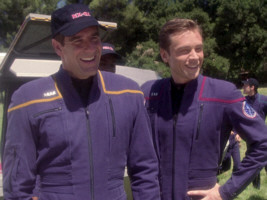
 Earth Starfleet uniforms in ENT: "Strange New World", 2151
Earth Starfleet uniforms in ENT: "Strange New World", 2151

